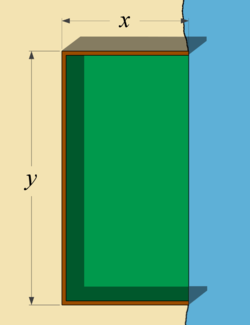Difference between revisions of "022 Sample Final A, Problem 2"
Jump to navigation
Jump to search
(Created page with "right|250px <span class="exam"> A dairy farmer plans to enclose a rectangular pasture adjacent to a river. To provide enough grass for his cows, the...") |
|||
| Line 13: | Line 13: | ||
!Step 1: | !Step 1: | ||
|- | |- | ||
| − | |'''Declare Variables:''' We are attempting to enclose a rectangular area, such that we use as little fencing as possible for the three fenced sides. Let's use <math style="vertical-align: | + | |'''Declare Variables:''' We are attempting to enclose a rectangular area, such that we use as little fencing as possible for the three fenced sides. Let's use <math style="vertical-align: 0px">x</math> and <math style="vertical-align: -4px;">y</math> as indicated in the image, and simply call the length of fencing required <math style="vertical-align: 0px">L</math>. |
|} | |} | ||
| Line 19: | Line 19: | ||
!Step 2: | !Step 2: | ||
|- | |- | ||
| − | |'''Form the Equations:''' With the variables declared, we need two fences of length <math style="vertical-align: 0px">x</math> and one fence of length <math style="vertical-align: | + | |'''Form the Equations:''' With the variables declared, we need two fences of length <math style="vertical-align: 0px">x</math> and one fence of length <math style="vertical-align: -4px;">y</math>. Together, we need a total length of <math style="vertical-align: -4px">L=2x+y</math>. |
|- | |- | ||
| − | |On the other hand, we know that the pasture has a fixed area of <math style="vertical-align: | + | |On the other hand, we know that the pasture has a fixed area of <math style="vertical-align: 0px">200</math> square meters. Thus, we also know that <math style="vertical-align: -4px;">xy=200</math>. |
|} | |} | ||
| Line 27: | Line 27: | ||
!Step 3: | !Step 3: | ||
|- | |- | ||
| − | |'''Optimize:''' Since <math style="vertical-align: - | + | |'''Optimize:''' Since <math style="vertical-align: -4px">xy=200</math>, we also know <math style="vertical-align: -4px;">y=200/x</math>. Plugging this into our equation for length, we have |
|- | |- | ||
| − | | | + | | |
| + | ::<math>L(x) \,=\, 2x +\frac{200}{x}.</math> | ||
|- | |- | ||
|We now take the derivative to find | |We now take the derivative to find | ||
|- | |- | ||
| − | | | + | | |
| + | ::<math>L'(x)\,=\,2-\frac{200}{x^2}\,=\,\frac{2x^2-200}{x^2}\,=\,\frac{2(x-10)(x+10)}{x^2}.</math> | ||
|- | |- | ||
| − | | | + | |This has roots <math style="vertical-align: 0px">\pm 10</math>. Of course, we can't have negative fencing lengths, so we can ignore the negative root. Finally, we use the area relation to find |
|- | |- | ||
| − | | | + | | |
| + | ::<math>y\,=\,\frac{200}{x}\,=\,\frac{200}{10}\,=\, 20. </math> | ||
|- | |- | ||
| − | | | + | |Thus, the least amount of fencing is used when we size our <math style="vertical-align: 0%;">200</math> sq. m. pasture as <math style="vertical-align: 0px">20</math> meters by <math style="vertical-align: 0px">10</math> meters. |
| + | |} | ||
| + | |||
| + | {| class="mw-collapsible mw-collapsed" style = "text-align:left;" | ||
| + | !Final Answer: | ||
|- | |- | ||
| − | | | + | |The pasture should be 20 meters by 10 meters. |
| − | |||
| − | |||
|} | |} | ||
| − | |||
[[009A_Sample_Final_A|'''<u>Return to Sample Exam</u>''']] | [[009A_Sample_Final_A|'''<u>Return to Sample Exam</u>''']] | ||
Revision as of 15:29, 5 June 2015
A dairy farmer plans to enclose a rectangular pasture adjacent to a river. To provide enough grass for his cows, the fenced pasture must contain 200 square meters of grass. If no fencing is required along the river, what dimensions will use the smallest amount of fencing?
| Foundations: |
|---|
| As a word problem, we must begin by assigning variables in order to construct useful equation(s). As an optimization problem, we will be taking a derivative of one of our equations in order to find an extreme point. |
Solution:
| Step 1: |
|---|
| Declare Variables: We are attempting to enclose a rectangular area, such that we use as little fencing as possible for the three fenced sides. Let's use and as indicated in the image, and simply call the length of fencing required . |
| Step 2: |
|---|
| Form the Equations: With the variables declared, we need two fences of length and one fence of length . Together, we need a total length of . |
| On the other hand, we know that the pasture has a fixed area of square meters. Thus, we also know that . |
| Step 3: |
|---|
| Optimize: Since , we also know . Plugging this into our equation for length, we have |
|
|
| We now take the derivative to find |
|
|
| This has roots . Of course, we can't have negative fencing lengths, so we can ignore the negative root. Finally, we use the area relation to find |
|
|
| Thus, the least amount of fencing is used when we size our sq. m. pasture as meters by meters. |
| Final Answer: |
|---|
| The pasture should be 20 meters by 10 meters. |













